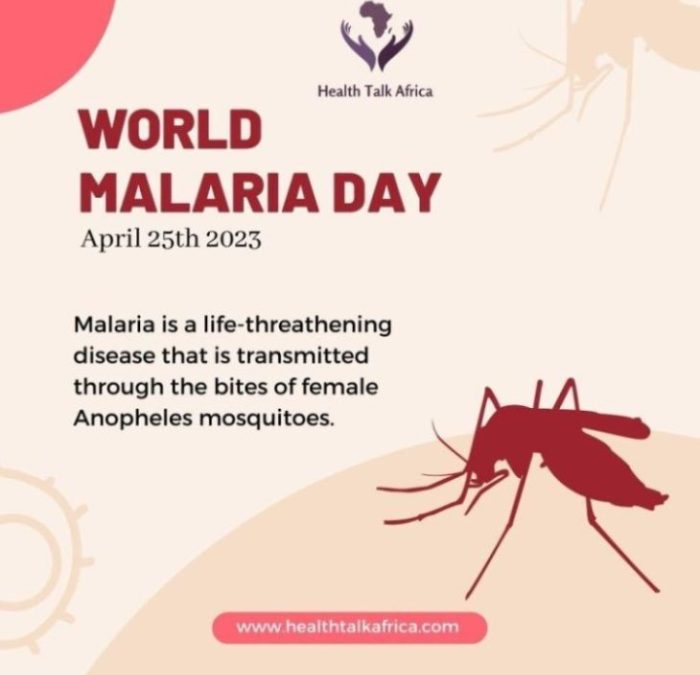Malaria is an acute febrile illness caused by Plasmodium parasites, which are spread to people through the bites of infected female Anopheles mosquitoes. It is preventable and curable.
Background
World Malaria Day is an international observance that is recognized every year on April 25th. As of 2023, this year’s World Malaria Day marks the 15th anniversary of the establishment of the event, which was first recognized in 2008.
The theme for World Malaria Day 2023 is “Time to deliver zero malaria: invest, innovate, implement” which highlights the global effort to eliminate malaria as a public health threat. The theme emphasizes the need for collective action, more efforts from government to prioritize funding to eliminate the disease, developmental strides in vaccines and diagnostics and expanding access to malaria services by delivering the World Health Organization’s recommended tools and strategies.
Malaria by numbers: global and regional burden
According to the latest World malaria report, published in December 2022, malaria claimed the lives of an estimated 619 000 people in 2021, compared to 625 000 in 2020. There were some 247 million new cases of malaria in 2021 compared to 245 million in 2020.
The African Region continues to shoulder the heaviest burden of the disease – accounting, in 2021, for an estimated 95% of all malaria cases (234 million) and 96% of all deaths (593 000). Nearly 80% of malaria deaths in the African Region were among children under the age of 5.
How is malaria transmitted?
Malaria is a life-threatening disease that is transmitted through the bites of female Anopheles mosquitoes. Five species of parasites can cause malaria in humans, and 2 of these species – Plasmodium falciparum and Plasmodium vivax – pose the greatest threat. There are over 400 different species of Anopheles mosquitoes and around 40, known as vector species, can transmit the disease.
Prevalence of malaria
Malaria occurs primarily in tropical and subtropical countries. The vast majority of malaria cases and deaths are found in the African Region, with nearly all cases caused by the Plasmodium falciparum parasite. This parasite is also dominant in other malaria hotspots, including the regions of South-East Asia, Eastern Mediterranean and Western Pacific. In the Region of the Americas, the Plasmodium vivax parasite is predominant, causing 75% of malaria cases.
According to the World Health Organization, the threat of malaria is highest in sub-Saharan Africa, and 4 countries in that region accounted for nearly half of all malaria deaths worldwide in 2021: Nigeria (26.6%), the Democratic Republic of the Congo (12.3%), Uganda (5.1%), and Mozambique (4.1%).
Malaria prevention
Malaria is a preventable disease.
1. Vector control interventions. Vector control is the main approach to prevent malaria and reduce transmission. Two forms of vector control are effective for people living in malaria-endemic countries. Use of insecticide-treated nets and spraying of insecticides to surfaces where mosquitoes tend to rest.
2. Chemopreventive therapies and chemoprophylaxis. Although designed to treat patients already infected with malaria, some antimalarial medicines can also be used to prevent the disease. Current WHO-recommended malaria chemopreventive therapies for people living in endemic areas include intermittent preventive treatment of malaria in pregnancy, perennial malaria chemoprevention, seasonal malaria chemoprevention, post-discharge malaria chemoprevention, and intermittent preventive treatment of malaria for school-aged children. Chemoprophylaxis drugs are also given to travelers before entering an area where malaria is endemic and can be highly effective when combined with insecticide-treated nets.
Malaria vaccine
RTS,S/AS01 (RTS,S) is the first and, to date, only vaccine that has demonstrated it can significantly reduce malaria in young children living in moderate-to-high malaria transmission areas. It acts against the Plasmodium falciparum parasite, the deadliest malaria parasite globally and the most prevalent in Africa.
Conclusion
World Malaria Day serves as an opportunity to raise awareness about the impact of malaria and to mobilize resources and support for the prevention and control of the disease. It is also a time to celebrate progress made in the fight against malaria and to renew commitments to ending the disease for good.


1 Comment